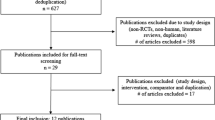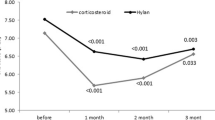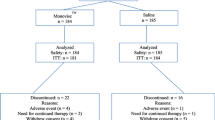Abstract
Purpose
A local injection of corticosteroid–lidocaine into the periarticular soft tissue structures is used commonly for rapid pain relief. It is hypothesized that knee pain associated with knee osteoarthritis would be relieved quickly and effectively in patients receiving intraarticular hyaluronic acid combined with a periarticular lidocaine–corticosteroid injection. To test this hypothesis, the clinical effect of the combined treatment with hyaluronic acid injection alone in patients with symptomatic knee osteoarthritis as compared in this prospective single-blinded randomized trial.
Methods
This study included 70 patients. Group 1 (n = 35) received intraarticular hyaluronic acid injections only, whereas group 2 (n = 35) received intraarticular hyaluronic acid injections combined with a single local injection of corticosteroid–lidocaine. Injections were administered to the most painful areas of the anterior or posterior medial condyle of the femur or tibia. The outcome was measured by independent assessors (blinded to treatment) using a linear VAS pain scale and WOMAC and HSS knee scores. Assessments were performed at baseline and at 1, 3, 6, 12, 26, and 52 weeks.
Results
During the first 3 weeks, group 2 patients showed significantly better all scores than did group 1 patients (p < 0.01). However, no significant differences were detected at 6, 12, 26 or 52 weeks (n.s.).
Conclusion
The combined treatment may lead to earlier pain relief compared with intraarticular hyaluronic acid alone in patients with knee osteoarthritis and can be considered a useful adjunctive treatment modality. This combined method may provide early return to patient’s daily activity.
Level of evidence
Therapeutic study, Level I.




Similar content being viewed by others
References
Altman R, Asch E, Bloch D et al (1986) Development of criteria for the classification and reporting of osteoarthritis. Classification of osteoarthritis of the knee. Diagnostic and Therapeutic Criteria Committee of the American Rheumatism Association. Arthritis Rheum 29:1039–1049
Altman RD, Rosen JE, Bloch DA et al (2009) A double-blind, randomized, saline-controlled study of the efficacy and safety of EUFLEXXA for treatment of painful osteoarthritis of the knee, with an open-label safety extension (the FLEXX trial). Semin Arthritis Rheum 39:1–9
Alvarez-Nemegyei J (2007) Risk factors for pes anserinus tendinitis/bursitis syndrome: a case control study. J Clin Rheumatol 13:63–65
Axe JM, Snyder-Mackler L, Axe MJ (2013) The role of viscosupplementation. Sports Med Arthrosc 21(1):18–22
Bannuru RR, Natov NS, Obadan IE et al (2009) Therapeutic trajectory of hyaluronic acid versus corticosteroids in the treatment of knee osteoarthritis: a systematic review and meta-analysis. Arthritis Rheum 61(12):1704–1711
Bannuru RR, Vaysbrot EE, Sullivan MC et al (2014) Relative efficacy of hyaluronic acid in comparison with NSAIDs for knee osteoarthritis: a systematic review and meta-analysis. Semin Arthritis Rheum 43(5):593–599
Bellamy N, Buchanan WW, Goldsmith CH et al (1988) Validation study of WOMAC: a health status instrument for measuring clinically important patient relevant outcomes to antirheumatic drug therapy in patients with osteoarthritis of the hip or knee. J Rheumatol 15:1833–1840
Bellamy N, Campbell J, Robinson V et al (2006) Viscosupplementation for the treatment of osteoarthritis of the knee. Cochrane Database Syst Rev 19:(2):CD005321
Brandt KD (2011) Why should we expect a structure-modifying osteoarthritis drug to relieve osteoarthritis pain? Ann Rheum Dis 70:1175–1177
Chou CW, Lue KH, Lee HS (2009) Hylan G-F 20 has better pain relief and cost-effectiveness than sodium hyaluronate in treating early osteoarthritic knees in Taiwan. J Formos Med Assoc 108:663–672
Collins NJ, Bierma-Zeinstra SM, Crossley KM et al (2013) Prognostic factors for patellofemoral pain: a multicentre observational analysis. Br J Sports Med 47(4):227–233
Creamer P (1997) Intra-articular corticosteroid injections in osteoarthritis: do they work and if so, how? Ann Rheum Dis 56(11):634–636
de Campos GC, Rezende MU, Pailo AF et al (2013) Adding triamcinolone improves viscosupplementation: a randomized clinical trial. Clin Orthop Relat Res 471(2):613–620
Folman Y, Shabat S (2011) Local treatment of a painful knee with cortiscosteroids: the efficacy of intra-articular injection compared with peri-articular soft tissue infiltration. J Musculoskelet Pain 19:154–157
Gigante A, Callegari L (2011) The role of intra-articular hyaluronan (Sinovial) in the treatment of osteoarthritis. Rheumatol Int 31(4):427–444
Gomoll AH, Kang RW, Williams JM et al (2006) Chondrolysis after continuous intra-articular bupivacaine infusion: an experimental model investigating chondrotoxicity in the rabbit shoulder. Arthroscopy 22:813–819
Helfenstein M Jr, Kuromoto J (2010) Anserine syndrome. Rev Bras Reumatol 50:313–327
Housman L, Arden N, Schnitzer TJ et al (2014) Intra-articular hylastan versus steroid for knee osteoarthritis. Knee Surg Sports Traumatol Arthrosc 22(7):1684–1692
Iannitti T, Lodi D, Palmieri B (2011) Intra-articular injections for the treatment of osteoarthritis: focus on the clinical use of hyaluronic acid. Drugs R D11:13–27
Inês LP, da Silva JA (2005) Soft tissue injections. Best Pract Res Clin Rheumatol 19:503–527
Insall JN, Ranawat CS, Aglietti P et al (1976) A comparison of four models of total knee-replacement prostheses. J Bone Joint Surg Am 58:754–765
Jørgensen A, Stengaard-Pedersen K, Simonsen O et al (2010) Intra-articular hyaluronan is without clinical effect in knee osteoarthritis: a multicentre, randomised, placebo-controlled, double-blind study of 337 patients followed for 1 year. Ann Rheum Dis 69:1097–1102
Karatosun V, Unver B, Gocen Z (2006) Intra-articular hyaluranic acid compared with progressive knee exercises in osteoarthritis of the knee: a prospective randomized trial with long-term follow-up. Rheumatol Int 26:277–284
Kellgren JH, Lawrence JS (1957) Radiological assessment of osteoarthrosis. Ann Rheumatol Dis 16:494–502
Leighton R, Akermark C, Therrien R et al (2014) NASHA hyaluronic acid vs. methylprednisolone for knee osteoarthritis: a prospective, multi-centre, randomized, non-inferiority trial. Osteoarthr Cartil 22(1):17–25
Leopold SS, Redd BB, Warme WJ (2003) Corticosteroid compared with hyaluronic acid injections for the treatment of osteoarthritis of the knee. A prospective, randomized trial. J Bone Joint Surg Am 85A:1197–1203
Lirk P, Picardi S, Hollmann MW (2014) Local anaesthetics: 10 essentials. Eur J Anaesthesiol 31:1–11
Liu L, Liu Y, Li J (2011) Microbial production of hyaluronic acid: current state, challenges, and perspectives. Microb Cell Fact 16(10):99
Nichols AW (2005) Complications associated with the use of corticosteroids in the treatment of athletic injuries. Clin J Sport Med 15(5):370–375
Ozturk C, Atamaz F, Hepguler S (2006) The safety and efficacy of intraarticular hyaluronan with/without corticosteroid in knee osteoarthritis: 1-year, single-blind, randomized study. Rheumatol Int 26:314–319
Papacrhistou G, Anagnostou S, Katsorhis T (1997) The effect of intraarticular hydrocortisone injection on the articular cartilage of rabbits. Acta Orthop Scand Suppl 275:132–134
Raman R, Dutta A, Day N (2008) Efficacy of hylan G-F 20 and sodium hyaluronate in the treatment of osteoarthritis of the knee—a prospective randomized clinical trial. Knee 15:318–324
Scott NA, Guo B, Barton PM (2009) Trigger point injections for chronic non-malignant musculoskeletal pain: a systematic review. Pain Med 10:54–69
Simons DG (2004) Review of enigmatic MTrPs as a common cause of enigmatic musculoskeletal pain and dysfunction. J Electromyogr Kinesiol 14:95–107
Stephens MB, Beutler AI, O’Connor FG (2008) Musculoskeletal injections: a review of the evidence. Am Fam Physician 78(8):971–976
Uson J, Aguado P, Bernad M (2000) Pes anserinus tendino-bursitis: what are we talking about? Scand J Rheumatol 29:184–186
Wang CT, Lin J, Chang CJ (2004) Therapeutic effects of hyaluronic acid on osteoarthritis of the knee. A meta-analysis of randomized controlled trials. J Bone Joint Surg Am 86A:538–545
Yentür EA, Okçu G, Yegül I (2004) The role of trigger point therapy in knee osteoarthritis. The Pain Clinic 15:385–390
Yoon HS, Kim SE, Suh YR (2005) Correlation between ultrasonographic findings and the response to corticosteroid injection in pes anserinus tendinobursitis syndrome in knee osteoarthritis patients. J Korean Med Sci 20:109–112
Zhang W, Moskowitz RW, Nuki G et al (2008) OARSI recommendations for the management of hip and knee osteoarthritis, part II: OARSI evidence-based, expert consensus guidelines. Osteoarthr Cartil 16(2):137–162
Author information
Authors and Affiliations
Corresponding author
Rights and permissions
About this article
Cite this article
Ertürk, C., Altay, M.A., Altay, N. et al. Will a single periarticular lidocaine–corticosteroid injection improve the clinical efficacy of intraarticular hyaluronic acid treatment of symptomatic knee osteoarthritis?. Knee Surg Sports Traumatol Arthrosc 24, 3653–3660 (2016). https://doi.org/10.1007/s00167-014-3398-2
Received:
Accepted:
Published:
Issue Date:
DOI: https://doi.org/10.1007/s00167-014-3398-2




